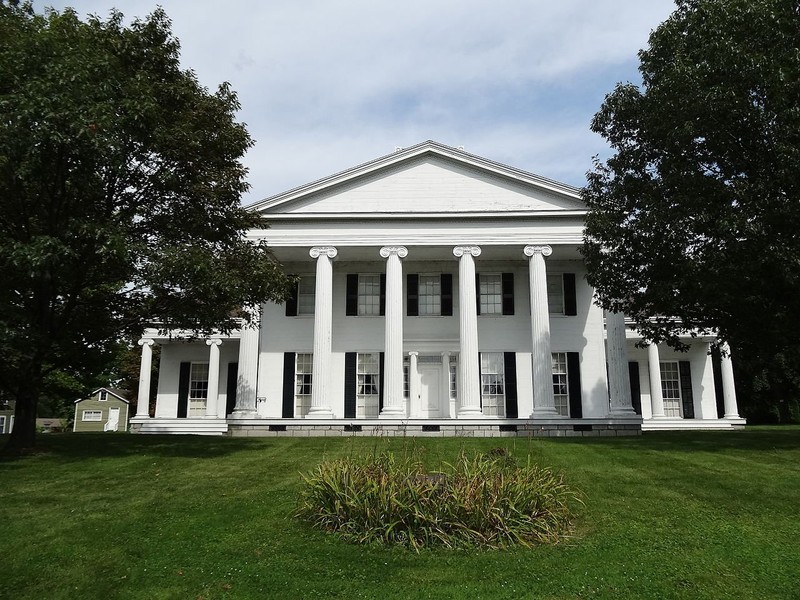Rose Hill Mansion
Introduction
Text-to-speech Audio
A National Historic Landmark, Rose Hill Mansion is a large residence situated on the eastern side of Seneca Lake. Constructed by wealthy New Yor City businessman William K. Strong in 1839, it is considered one of the finest examples of Greek Revival architecture in the country. Along with the other large mansions in Geneva, Rose Hill Mansion reflects the wealth of the area generated as a result of the Erie Canal (built between 1821-1825), which stretched east to west from the Hudson River just north of Albany to Buffalo. Three main branches extended from the canal, including one (the Cayuga and Seneca Canal), that reached Seneca Lake.
Today, Rose Hill Mansion is operated as a museum by the Geneva Historical Society. The home features period furniture, household items, and numerous paintings on display. Visitors will also learn about how owner Robert Swan pioneered farming techniques to increase agricultural output. Rose Hill is also notable for its large number of slaves, who comprised one of the largest concentrations of slaves in the state.
Images
Rose Hill Mansion was built in 1839. It was declared a National Historic Landmark for its Greek Revival architecture, which is considered among the finest in the country.

Backstory and Context
Text-to-speech Audio
William Strong bought the property in 1802 and built a much smaller house that is now the Visitor Center. He earned his wealth in the banking industry, becoming an elite member of society, a position that afforded him the opportunity to host President Martin Van Buren (in office from 1837-1841) at the mansion.
Robert Swan's father, who was a very wealthy man himself (one of the richest in New York City), purchased Rose Hill in 1850 as a wedding gift for Robert and his wife Margaret Johnston, who got married that year. Robert had been in Geneva since 1848 when he moved from New York City to restore his health (it is not clear what was ailing him). He lived with a local family, the Johnstons, to learn farming. During this time, he fell in love with Margaret.
The farming technique Robert devised was to use drainage tiles throughout the farm to get rid of spring water. During the first year on the farm, he installed 16,000 tiles. Happy with the results, he eventually installed 61 miles of tiles on the farm which was 344 acres in size. He increased productivity from five bushels per acre to 50 bushels. His success earned him an award from the New York State Agricultural Society in 1858, to which he became its president in 1881.
After he died in 1890, farming ended and gradually the house fell into disrepair. For a time it was even used as a nursing home. The Geneva Historical Society acquired it in the mid-1960s.
Slaves were present at the property since Scottish-born doctor Alexander Coventry bought 900 acres in 1792. The site of the house was part of the land Alexander owned. The slaves he brought with him were a husband and wife and two of her children. The husband, Cuff, was able to secure some independence from Alexander in that he was allowed to grow crops and trap animals (he collected the fur) for his family. He was also allowed to sell these goods and keep the profits. The Coventry family moved to Utica in 1796. It is not entirely clear what happened to Cuff, his wife, and the children. Cuff might have been sold to another master in 1809.
Robert Swan's father, who was a very wealthy man himself (one of the richest in New York City), purchased Rose Hill in 1850 as a wedding gift for Robert and his wife Margaret Johnston, who got married that year. Robert had been in Geneva since 1848 when he moved from New York City to restore his health (it is not clear what was ailing him). He lived with a local family, the Johnstons, to learn farming. During this time, he fell in love with Margaret.
The farming technique Robert devised was to use drainage tiles throughout the farm to get rid of spring water. During the first year on the farm, he installed 16,000 tiles. Happy with the results, he eventually installed 61 miles of tiles on the farm which was 344 acres in size. He increased productivity from five bushels per acre to 50 bushels. His success earned him an award from the New York State Agricultural Society in 1858, to which he became its president in 1881.
After he died in 1890, farming ended and gradually the house fell into disrepair. For a time it was even used as a nursing home. The Geneva Historical Society acquired it in the mid-1960s.
Slaves were present at the property since Scottish-born doctor Alexander Coventry bought 900 acres in 1792. The site of the house was part of the land Alexander owned. The slaves he brought with him were a husband and wife and two of her children. The husband, Cuff, was able to secure some independence from Alexander in that he was allowed to grow crops and trap animals (he collected the fur) for his family. He was also allowed to sell these goods and keep the profits. The Coventry family moved to Utica in 1796. It is not entirely clear what happened to Cuff, his wife, and the children. Cuff might have been sold to another master in 1809.
Sources
Pitts, Carolyn. "Rose Hill Mansion." National Park Service - National Register of Historic Places Nomination Form. February 06, 1973. https://npgallery.nps.gov/GetAsset/0ba9300d-5b23-4a13-af2d-b87b0114ae4d.
"Rose Hill." National Parks Service - National Historic Landmarks Program. Accessed from WebArchive on December 24, 2018. https://web.archive.org/web/20110606004759/http://tps.cr.nps.gov/nhl/detail.cfm?ResourceId=1354&ResourceType=Building.
"Slavery at Rose Hill." [Pdf Article] Seneca County https://www.co.seneca.ny.us/wp-content/uploads/2014/11/Slavery-at-Rose-Hill-ADA.pdf.
Photo: Wikimedia Commons
"Rose Hill." National Parks Service - National Historic Landmarks Program. Accessed from WebArchive on December 24, 2018. https://web.archive.org/web/20110606004759/http://tps.cr.nps.gov/nhl/detail.cfm?ResourceId=1354&ResourceType=Building.
"Slavery at Rose Hill." [Pdf Article] Seneca County https://www.co.seneca.ny.us/wp-content/uploads/2014/11/Slavery-at-Rose-Hill-ADA.pdf.
Photo: Wikimedia Commons
